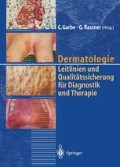Zusammenfassung
Das atopische Ekzem gehört zu den häufigsten Hauterkrankungen, bei siebenjährigen Schulkindern ist die Prävalenz derzeit etwa 15% [17]. Zwar konnte die Ätio- pathogenese dieser so häufigen Krankheit bisher nicht endgültig geklärt werden, jedoch wurden in letzter Zeit zahlreiche Erkenntnisse gewonnen, die unsere Vorstellungen über den Pathomechanismus des atopischen Ekzems erweitert und befruchtet haben [2, 5, 7, 10,14]. Typische und offensichtlich für die Pathogenese bedeutsame Befunde bei Patienten sind
-
immunologische Auffälligkeiten, so die gesteigerte IgE-Immunantwort, eine zumindest temporäre Dominanz von Th2-ähnlichen Zellen und eine Aktivierung von Eosinophilen,
-
eine veränderte pharmakologische Reaktivität mit ß-adrenerger Blockade bei α-adrenerger und cholinerger Überreaktivität und
-
gestörte epidermale Funktionen mit veränderten Hautlipiden und gestörter Barrierefunktion („trockene Haut“).
Access this chapter
Tax calculation will be finalised at checkout
Purchases are for personal use only
Preview
Unable to display preview. Download preview PDF.
Literatur
Atherton DJ, Carabott F, Glover MT, Hawk JML (1988) The role of psoralen photochemotherapy (PUVA) in the treatment of severe atopic eczema in adolescents. Br J Dermatol 118: 791–795
Bos JD, Kapsenberg ML, Sillevis Smitt JH (1994) Pathogenesis of atopic eczema. Lancet 343: 1338–1341
Fuglsang G, Madsen C, Haiken S, Jorgensen M, Ostergaard PA, Osterballe O (1994) Adverse reactions to food additives in children with atopic symptoms. Allergy 49: 31–37
Gieler U, Ehlers A, Höhler T, Burkard G (1990) Die psychosoziale Situation der Patienten mit endogenem Ekzem. Eine clusteranalytische Studie zur Korrelation psychischer Faktoren mit somatischen Befunden. Hautarzt 41: 416–423
Hanifin JM (1996) Assembling the puzzle pieces in atopic inflammation. Arch Dermatol 132: 1230–1232
Hannuksela A, Kinnunen T (1992) Moisturizers prevent irri¬tant dermatitis. Acta Derm Venereol (Stockh) 72: 42–44
Kapp A (1993) Die Rolle eosinophiler Granulozyten für die Pathogenese der atopischen Dermatitis/Neurodermitis. Eosinophilen-Produkte als Marker der Krankheitsaktivität. Hautarzt 44: 432–436
Larramendi CH, Martin Esteban M, Pascual Marcos C, Fiandor A, Pena Diaz JM (1992) Possible consequences of elimination diets in asymptomatic immediate hypersensitivity to fish. Allergy 47: 490–494
Morren MA, Przybilla B, Bamelis M, Heykants B, Reynaers A, Degreef H (1994) Atopic dermatitis: triggering factors. J Am Acad Dermatol 31: 467–473
Ogawa H, Yoshiike T (1993) A speculative view of atopic dermatitis: barrier dysfunction in pathogenesis. J Dermatol Sei 5: 197–204
Przybilla B, Eberlein-König B, Ruéff F (1994) Practical management of atopic eczema. Lancet 343: 1342–1346
Przybilla B, Ruéff F (1997) Oraler Provokationstest. In: Körting HC, Sterrry W (Hrsg) Diagnostische Verfahren in der Dermatologie. Blackwell, Berlin Wien, S 123–131
Ring J, Abeck D, Neuber K (1992) Atopie eczema: role of microorganisms on the skin surface. Allergy 47: 265–269
Ring J, Bieber T, Vieluf D, Kunz B, Przybilla B (1991) Atopic eczema, Langerhans cells and allergy. Int Arch Allergy Appl Immunol 94: 194–201
Sampson HA, McCaskill CC (1985) Food hypersensitivity and atopic dermatitis: evaluation of 113 patients. J Pediatr 107: 669–675
Sanda T, Yasue T, Oohashi M, Yasue M (1992) Effectiveness of house dust mite allergen avoidance through clean room therapy in patients with atopic dermatitis. J Allergy Clin Immunol 89: 653–657
Schultz Larsen F, Diepgen T, Svensson Á (1996) The occurrence of atopic dermatitis in North Europe: an international questionnaire study. J Am Acad Dermatol 34: 760–764
Vickers CFH (1991) Natural history of atopic eczema. In: Ruzicka T, Ring J, Przybilla B (Hrsg) Handbook of atopic eczema. Springer, Berlin Heidelberg New York Tokyo, pp 80–83
Editor information
Editors and Affiliations
Rights and permissions
Copyright information
© 1998 Springer-Verlag Berlin Heidelberg
About this paper
Cite this paper
Przybilla, B., Ruëff, F. (1998). Therapie des atopischen Ekzems. In: Garbe, C., Rassner, G. (eds) Dermatologie. Springer, Berlin, Heidelberg. https://doi.org/10.1007/978-3-642-71974-5_22
Download citation
DOI: https://doi.org/10.1007/978-3-642-71974-5_22
Publisher Name: Springer, Berlin, Heidelberg
Print ISBN: 978-3-642-71975-2
Online ISBN: 978-3-642-71974-5
eBook Packages: Springer Book Archive

